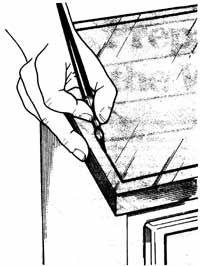How to Paint Stripes on Furniture
Adding stripes is another quick and easy way to style and decorate wooden furniture. Painting edge stripes on enameled or antiqued furniture can add distinction to flat surfaces -- use one thin border stripe or paint multiple stripes or geometric borders.
Tabletops, chair seats, and similar areas are good candidates for striping, but any flat surface can be decorated with stripes. Use high-gloss or semigloss enamel, slightly thinned; make sure it's compatible with the existing finish.
Advertisement
Application Techniques
Freehand Striping: Freehand stripes take a steady hand and a good brush, but they aren't difficult on a fairly small piece. The surface to be striped must be clean; remove all wax and dirt. Use a good-quality artists' brush, with a small diameter and a good point. Practice striping on a piece of cardboard before you work on a piece of furniture.
Stripes close to the edge of a surface can be applied without a straightedge or other guide. Hold the brush with your thumb and first two fingers and rest your other two fingers on the edge of the surface; keeping the brush steady on the surface, draw your hand along the edge. This method is effective for edge stripes on curved or straight surfaces. For stripes too far from a straight edge for this technique, use a yardstick as a guide to draw your hand along; have an assistant hold the stick in place as you paint.
Apply enamel carefully, loading the brush enough to make a complete stripe but not enough to blob or drip. Keep your pressure steady as you draw the brush along the edge of the surface; practice on cardboard to get a feel for the technique. If the brush doesn't hold its point or spreads out too far, try turning it slightly as you draw it along. This will re-form the brush as you work.
For double stripes or designs with more than one color, let each stripe dry completely before you paint the next one. Work from the inside stripe out to avoid smudging.

Taped Striping: On long edges, or for wide stripes, use painter's tape to define the stripes. The surface must be clean, with all wax and dirt removed. Carefully press the tape along the surface; make sure it's straight, and at a consistent distance from the edge. Seal the edges of the tape carefully to keep the paint from seeping under it; press each tape edge firmly all along its length with your thumbnail or the tip of a putty knife.
Apply the enamel with a good-quality artists' brush, roughly the same width as the masked stripe. Use enough paint to cover the surface completely, but smooth it out well; don't let the stripe get thick or uneven. Let the paint dry completely. Then remove the tape, pulling it gently away from the surface. Do not leave the tape on the surface for more than 12 hours, or it may damage the finish.
For double stripes or designs with more than one color, let each stripe dry completely before you tape the next one. Apply tape very carefully where stripes cross, to keep it from damaging the earlier stripes. Work from the inside of the surface toward the edges.
Protecting the Surface
To prevent damage to the stripes, the surface should be sealed with varnish. Apply a coat of varnish directly over the stripes.
If you are working with inexpensive furniture, decals are another option for sprucing up your piece. Check out when and how to use decals in the next section.
